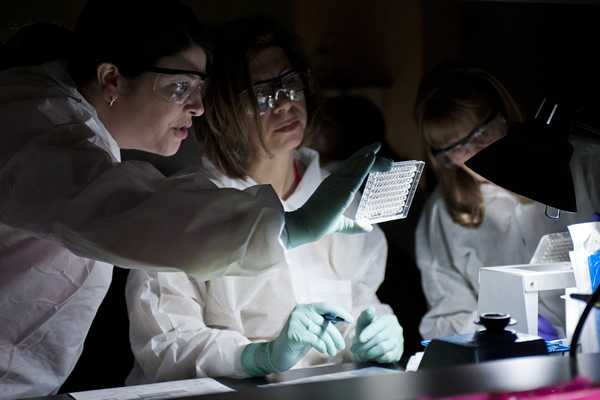Antibiotic Resistance (AR) Lab Network Established as New Fungal Threat Emerges
We now live in a time when Americans are dying of untreatable resistant infections. CDC is committed to supporting vital laboratory capacity in every state to rapidly detect new forms of antibiotic resistance through its Antibiotic Resistance Laboratory Network (AR Lab Network).

At an ARLN lab training hosted by CDC, microbiologists Sandra Boyd (CDC), Hala Ayad, and Carol Rodriguez (ARLN Mountain Regional Lab) view results of a broth microdilution panel, the reference method for antimicrobial susceptibility testing.
The new network was established in 2016 with support from Congress. As new or rare forms of antibiotic resistance emerge, CDC’s AR Lab Network supports nationwide capacity to rapidly detect these threats in health care, food, and the community, and inform local responses to prevent spread and protect people. The AR Lab Network consists of improved lab infrastructure and capacity in all 50 states and Puerto Rico, six large cities, seven regional labs, and—new in 2017—a nationwide tuberculosis molecular surveillance lab.
One example of the AR Lab Network’s importance and early success is highlighted in its response to the emerging resistant fungus, Candida auris (C. auris). This fungus poses a unique challenge to public health because it can cause invasive and often deadly infections that can be resistant to multiple antifungal drugs. It is particularly concerning because it can spread to other patients.
An additional challenge presented by C. auris is that specialized laboratory methods are needed to accurately identify it. Conventional or outdated lab techniques in healthcare facilities often lead to misidentification and inappropriate treatment of C. auris, making it difficult to control its spread and save lives in healthcare settings.
CDC’s AR Lab Network Responds
When this threat emerged in the United States in 2016, CDC’s staff responded nimbly and aggressively to fill detection gaps through the AR Lab Network:
Transformative Investments
CDC is making transformative improvements using resources provided by Congress in fiscal year 2016 and 2017 to further identify and respond to C. auris with activities like:
- Healthcare-Associated Infection (HAI)/AR Detect & Respond Programs: CDC is enhancing national infrastructure in 50 states and Puerto Rico, six major cities, and seven regions to ensure rapid identification and containment of resistant threats, like C. auris, across all healthcare settings.
- Antibiotic Resistance (AR) Laboratory Network: Regional labs in the AR Lab Network will test for and support response to new forms of Candida resistance in the United States.
- Emerging Infections Program (EIP): CDC is enhancing tracking of Candida to better understand the yeast through EIP, a national network utilized for tracking, preventing, and controlling emerging infectious diseases.
- AR Isolate Bank: Diagnostic labs can use CDC’s C. auris samples to calibrate, or standardize, their diagnostic tests so they can accurately identify and characterize this emerging threat.
- With specialized testing techniques supported by CDC, the AR Lab Network Northeast Regional Lab tested and analyzed 318 isolates between July 2016 and June 2017. Improved testing capabilities mean stronger data that can be used to evaluate transmission, stop spread, and inform future prevention strategies.
- In response to the growing threat, all AR Lab Network regional labs offer confirmatory testing for local labs and will add C. auris colonization testing to their testing menu in fall 2017. Patients who are colonized with C. auris may not show symptoms but still spread it within and across healthcare facilities. Colonization testing is vital for facilities and health departments to identify hidden reservoirs of disease that help focus prevention strategies to interrupt transmission.
- Regional labs forward confirmed isolates to CDC for additional testing and DNA-sequencing, which can determine if and how the isolate is related to other samples and provide big-picture data for the overall threat. CDC gold-standard lab methods have uncovered, for example, that four distinct C. auris strains have emerged simultaneously across the globe. Read the C. auris story for a full summary of CDC’s early lab findings and prevention and response activities.
- CDC identifies and validates specialized lab methods before new testing is implemented by the network, as well as trains regional lab staff on susceptibility and colonization techniques, to ensure consistency and accuracy nationwide.
- The AR Lab Network also funnels some samples of new and emerging threats to the CDC and FDA AR Isolate Bank. AR Lab Network labs can use the AR Isolate Bank C. auris collection to rapidly validate and implement testing methods.
Agile Infrastructure Means Rapid Response to New Threats
Because antibiotic resistance occurs as a part of a natural evolution process, it can be significantly slowed but not stopped. New threats will continue to emerge. The agility of the AR Lab Network means that gold-standard testing techniques can be quickly scaled up nationwide when new resistant threats, like C. auris and “nightmare bactiera” CRE, are found. To keep Americans safe, CDC’s AR Lab Network will continue to make enhancements in direct response to new threats and their potential spread.
To read more about other new features of the AR Lab Network, like the National TB Molecular Surveillance Center, and CDC’s other AR prevention and response activities, visit the AR Solutions Initiative page.
- Page last reviewed: August 9, 2017
- Page last updated: August 9, 2017
- Content source:


 ShareCompartir
ShareCompartir